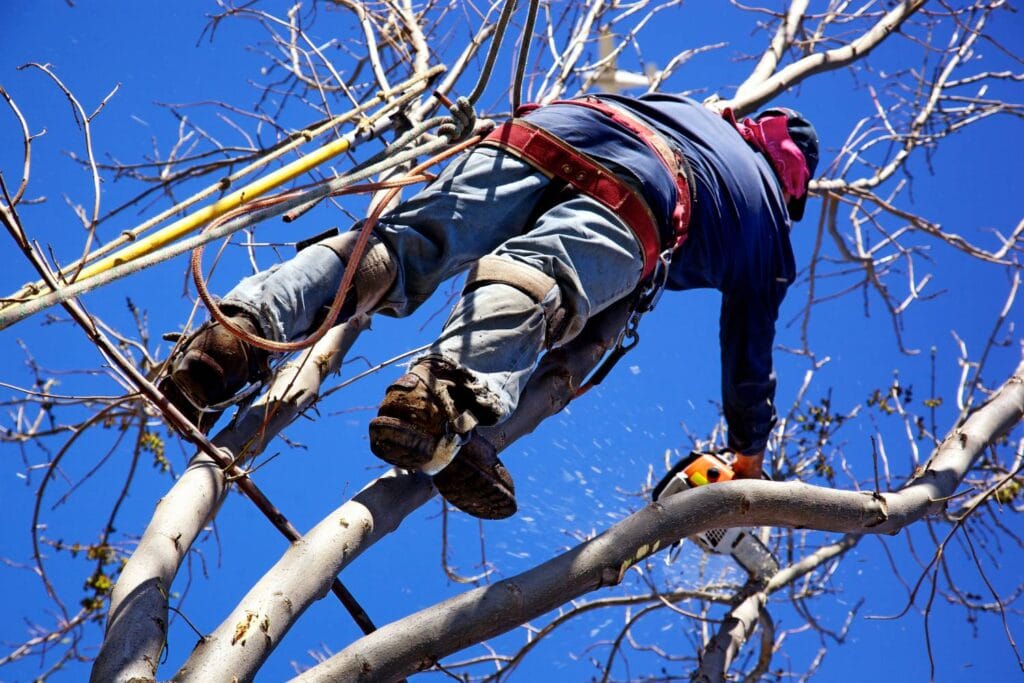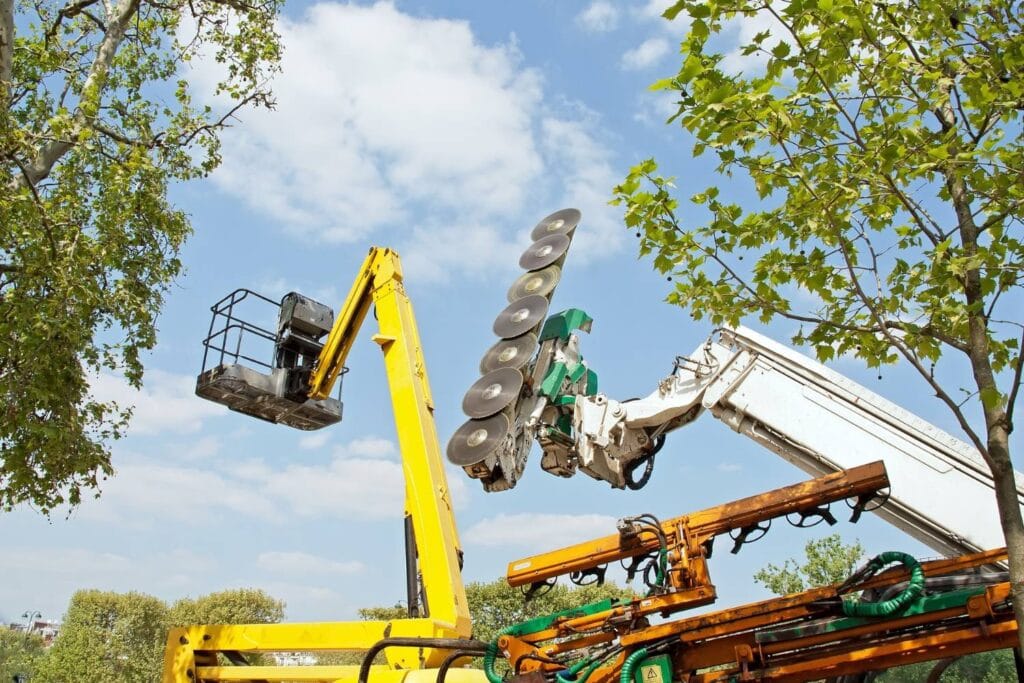Maintaining trees in residential areas is not only about aesthetics but also about ensuring their health and safety. One common practice associated with tree care, especially in urban settings, is tree lopping. Determining how often tree lopping is necessary involves careful consideration of multiple factors to safeguard the trees’ health and the surrounding environment.
Understanding Tree Lopping
Tree lopping, often misunderstood as a routine pruning practice, involves the significant removal of large sections of a tree’s crown or branches. Unlike standard pruning techniques aimed at maintaining tree health and structure, lopping typically focuses on reducing the size of a tree’s canopy or limbs for specific reasons such as hazard mitigation, clearance for structures or utilities, or aesthetic preferences.

Key Aspects of Tree Lopping
- Purpose and Intent: The primary objective of tree lopping is usually to manage the size or shape of a tree. This can be necessary in urban or suburban settings where trees may grow too large for their surroundings or pose risks to property or safety.
- Impact on Tree Health: Improper lopping techniques can severely damage a tree. When large branches are removed indiscriminately, it exposes the tree to potential infections, decay, and stress. This can compromise its structural integrity and longevity.
- Regulatory Considerations: Many regions have regulations governing tree care practices, including lopping. These regulations often emphasise the importance of responsible tree management to protect both trees and the surrounding environment.
- Alternative Practices: In many cases, alternative pruning methods such as crown reduction pruning or selective branch removal may achieve similar goals without causing as much harm to the tree. These methods preserve the tree’s natural shape and promote healthy growth.
- Consulting Arborists: Before deciding on lopping, consulting with certified arborists or tree care professionals is crucial. They can assess the tree’s health, structural stability, and specific needs, offering expert advice on the most appropriate course of action.
Dormant Season Lopping
In the context of residential tree care, dormant season lopping refers to the practice of pruning or lopping trees during their dormant period, typically in late fall to early spring. This period is chosen for several practical reasons that influence the effectiveness and health outcomes of lopping activities.
Optimal Timing
Lopping during the dormant season is preferred because trees are in such a dormant state, meaning they are not actively undergoing growth. During dormancy, trees are less vulnerable to stress and infections that may result from pruning wounds.
This period allows the tree to heal and seal pruning cuts more effectively before the vigorous growth phase resumes in spring. By avoiding the active growth period, dormant season lopping minimises the risk of sap loss, which can weaken the tree and attract pests.
Enhanced Visibility and Access
The dormant season often coincides with reduced foliage, providing arborists with better visibility of the tree’s structure. This clearer view allows for more precise pruning decisions, ensuring that cuts are strategically made to maintain tree health, improve aesthetics, and manage risks effectively. Additionally, reduced foliage makes it easier to access and manoeuvre around the tree, facilitating safer and more efficient lopping practices.
Mitigation of Seasonal Risks
Lopping during the dormant season helps mitigate seasonal risks associated with overgrown branches. By reducing the size and weight of the tree’s canopy before winter storms or heavy snowfall, dormant season lopping decreases the likelihood of branch breakage and property damage. This proactive approach to tree care enhances safety for residents and protects surrounding infrastructure during adverse weather conditions.
Incorporating dormant season lopping into residential tree care practices offers numerous advantages, including improved tree health, enhanced safety, and regulatory compliance. By scheduling lopping activities during the dormant period and considering species-specific factors, homeowners and arborists can effectively manage tree maintenance while promoting the long-term vitality and aesthetic appeal of residential landscapes.
Factors Influencing Frequency
Determining the frequency of tree lopping in residential areas hinges on several key factors that influence the health, safety, and aesthetic considerations of trees.
Tree Species and Growth Rate
Different tree species display varied growth rates, influencing the frequency of lopping required in residential areas. Fast-growing species tend to necessitate more frequent pruning or lopping to manage their size and shape compared to slower-growing counterparts. Understanding these growth characteristics is crucial for determining appropriate lopping intervals.
For instance, trees like poplars or some eucalyptus species can rapidly grow large canopies, potentially requiring more frequent maintenance to keep them within safe and manageable limits. In contrast, slow-growing trees such as oaks or beeches may need less frequent lopping, primarily for safety or aesthetic reasons rather than vigorous growth control.
Health and Condition of the Tree
The vitality and physical condition of a tree significantly influence the need for lopping in residential settings. Trees that are unhealthy, damaged, or structurally compromised may require more frequent and careful lopping to mitigate risks and foster recovery. Regular inspections by qualified arborists are essential to detect signs of disease, pest infestations, or structural weaknesses that could compromise the tree’s stability or safety.
For example, diseased trees may require targeted lopping to remove affected branches and prevent the spread of pathogens. Similarly, trees with structural defects like weak unions or deadwood might need proactive lopping to reduce the hazard of branch failure during storms or high winds.
Purpose of Lopping
In residential areas, tree lopping serves primarily to mitigate potential hazards posed by overgrown branches or trees. Trees situated near structures, power lines, or areas with high pedestrian or vehicular traffic can pose significant safety risks if left unmanaged. Overgrown branches may encroach upon buildings, obstruct visibility along roads, or threaten to fall during storms, potentially causing damage or injury.
Lopping addresses these concerns by reducing the size and weight of a tree’s canopy, thereby maintaining safe clearances and minimising risks of accidents or property damage. By strategically removing branches that pose immediate hazards, homeowners and arborists ensure a safer living environment for residents while preserving the structural integrity of surrounding infrastructure.
Local Regulations and Guidelines
Compliance with local regulations governing tree care practices, including lopping, is paramount in residential settings. Many municipalities have established guidelines to safeguard their urban ecosystems and ensure responsible tree management practices. These regulations typically outline permissible lopping practices, specify timing restrictions for pruning activities, and may require obtaining permits before undertaking significant tree maintenance work.
By adhering to these guidelines, homeowners not only avoid potential fines but also contribute to environmental conservation efforts by preserving the health and aesthetics of urban green spaces. Local authorities may also enforce regulations to protect endangered species, preserve heritage trees, or maintain the overall ecological balance within residential communities.
Understanding and complying with local regulations fosters a harmonious relationship between homeowners, arborists, and local authorities, promoting sustainable tree care practices that benefit both residents and the broader community.
Guidelines for Residential Areas
In residential settings, the frequency of tree lopping should be guided by specific principles to ensure the health, safety, and aesthetic integrity of trees.
Assessment by Professionals
Before embarking on any tree lopping in residential areas, seeking the expertise of qualified arborists or tree care professionals is paramount. These professionals bring specialised knowledge and skills to assess various aspects of tree health and structural integrity, which are critical for making informed decisions about pruning and lopping.
Evaluation of Growth Patterns
Understanding the tree’s growth patterns is essential for determining appropriate lopping strategies. Arborists analyse the tree’s growth trajectory, considering factors such as branch growth direction and spacing.
This evaluation helps in shaping the tree to promote balanced growth and structural integrity over time. Properly spaced branches reduce competition among limbs and improve airflow through the canopy, reducing the likelihood of disease and improving overall tree health.
Informed Recommendations
Based on their comprehensive assessment, arborists provide homeowners with informed recommendations regarding the necessity and extent of lopping required. They outline specific pruning techniques tailored to address safety concerns, enhance tree aesthetics, and support long-term health.
This professional guidance ensures that lopping activities are conducted in a manner that optimises tree health while addressing potential hazards linked to excessively grown or structurally compromised trees.

Safety Considerations
The primary reason for lopping in residential areas often revolves around safety concerns. Overgrown branches can pose hazards to nearby structures, power lines, pedestrians, and vehicles. Lopping may be necessary to maintain safe clearances and reduce risks of falling branches during storms or adverse weather conditions.
Arborists evaluate the specific safety risks posed by the tree’s branches and canopy. They assess the proximity of branches to structures and utilities, considering potential damage or obstruction during inclement weather. By strategically lopping branches that pose immediate risks, arborists help mitigate potential accidents and property damage.
Avoid Over-Lopping
While addressing safety and aesthetic concerns, it is essential to avoid excessive lopping. Over-lopping can weaken the tree’s structure, Over-pruning can weaken the tree’s structure, disturb its natural growth patterns, and increase its vulnerability to diseases and pests. Whenever possible, alternative pruning techniques such as selective branch removal or crown reduction pruning should be considered to achieve desired outcomes without compromising the tree’s health.
Conclusion
Determining the frequency of tree lopping in residential areas involves a balanced approach that considers multiple factors impacting tree health, safety, and aesthetic appeal. Tree lopping, while often necessary for hazard mitigation and structural management, should be approached with caution to avoid detrimental effects on tree vitality.
Consulting with certified arborists or tree care professionals is essential to assess the specific needs of trees, ensuring that pruning, including lopping, is conducted judiciously and in accordance with best practices.
Moreover, adherence to local regulations governing tree care practices not only promotes environmental stewardship but also fosters a safe and harmonious living environment for residents. By integrating these considerations into residential tree management strategies, homeowners can maintain healthy trees, mitigate risks, and contribute positively to the urban landscape for years to come.
Frequently Asked Questions
Why Is Tree Lopping Necessary in Residential Areas?
Tree lopping is necessary to manage the size or shape of trees that have grown too large for their surroundings or pose safety risks. It helps maintain safe clearances from structures, power lines, and roads, reducing the likelihood of accidents during adverse weather.
What Are the Potential Risks of Improper Tree Lopping?
Improper lopping can severely damage trees by exposing them to infections, decay, and stress. It may compromise the tree’s structural integrity and longevity, leading to increased vulnerability to diseases and pest infestations.
When Is the Best Time to Lop Trees in Residential Areas?
Dormant season lopping, typically done in late fall to early spring when trees are dormant, is generally preferred. During their dormant period, trees are less prone to stress and infections from pruning wounds, allowing for better healing and minimising risks associated with active growth periods.
How Can Homeowners Ensure They Are Complying With Local Regulations for Tree Lopping?
Homeowners should familiarise themselves with local regulations governing tree care practices, including lopping. These regulations often specify permissible practices, timing restrictions, and may require obtaining permits for significant pruning activities. Adhering to these guidelines helps protect urban ecosystems and avoids potential fines.
What Alternative Pruning Methods Can Be Considered Instead of Lopping?
Crown reduction pruning and selective branch removal are effective alternatives to lopping. These methods help achieve similar goals of hazard mitigation and aesthetic improvement without compromising the tree’s health. They preserve the tree’s natural shape and promote healthier growth patterns over time.

